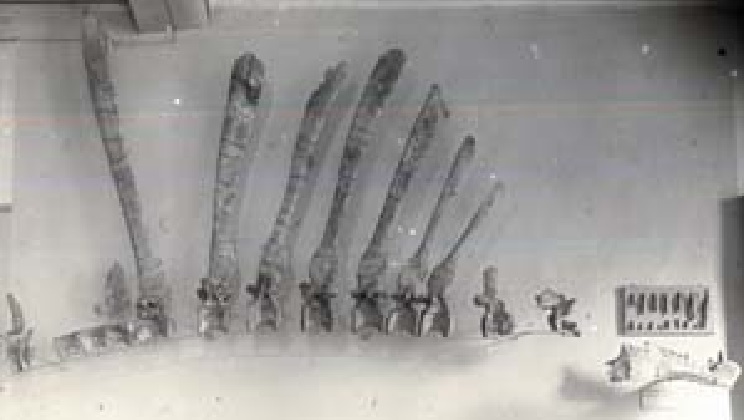
One of the photographs donate by W. Stromer. Image from the Washington University in St. Louis
Despite its low fossil record, Spinosaurus is one of the most famous dinosaur of all time. This gigantic theropod possessed highly derived cranial and vertebral features sufficiently distinct for it to be designated as the nominal genus of the clade Spinosauridae. In 1910, E. Stromer went to his third paleontological expedition to Egypt. He arrived to Alexandria on November 7. He was initially looking for early mammals and planned visit the area of Bahariya, in the Western Desert, which has sediments from the Cretaceous era. But an expedition to the Western Desert needed the permission by the English and French colonial authorities and of course the Egyptian authorities. Although diplomatic relations with Germany were rapidly deteriorating, Stromer managed to get the permissions. He arrived to the Bahariya Oasis on January 11, 1911. After facing some difficulties during the journey, on January 17 he began to explore the area of Gebel el Dist, and at the bottom of the Bahariya Depression, Stromer found the remains of four immense and entirely new dinosaurs (Aegyptosaurus, Bahariasaurus, Carcharodontosaurus and Spinosaurus aegyptiacus), along with dozens of other unique specimens. Stromer and Markgraf recovered the right and left dentaries and splenials from the lower jaw; a straight piece of the left maxilla that was described but not drawn; 20 teeth; 2 cervical vertebrae; 7 dorsal (trunk) vertebrae; 3 sacral vertebrae; 1 caudal vertebra; 4 thoracic ribs; and gastralia. This gigantic predator is estimated to have been about 14 m, with unusually long spines on its back that probably formed a large, sail-like structure.

1) Photograph of the right mandibular ramus of the holotype of Spinosaurus aegyptiacus Stromer, 1915 (BSP 1912 VIII 19), in lateral view. 2) Reproduction of Stromer’s (1915, pl. I, fig. 12a) illustration of the right mandibular ramus.
Due to political tensions before and after World War I, many of this fossils were damaged after being inspected by colonial authorities and not arrived to Munich until 1922. The shipping from El Cairo was paid by the Swiss paleontologist Bernhard Peyer (1885-1963), a former student and friend of Stromer. During the World War II, E. Stromer tried to convince Karl Beurlen -a young nazi paleontologist who was in charge of the collection- that he had to move the fossils to a safer place, but Beurlen refused to do it. Unfortunately, on April 24, 1944, a British Royal Air Force raid bombed the museum and incinerated its collections. Only two photographs of the holotype of Spinosaurus aegyptiacus were recovered in in the archives of the Paläontologische Museum in June 2000, after they were donated to the museum by Ernst Stromer’s son, Wolfgang Stromer, in 1995. These photographs provide additional insight into the anatomy of the holotype specimen of Spinosaurus aegyptiacus.

“Illustrations of the vertebrate “sail” bones of Spinosaurus that appeared in one of Stromer’s monographs. From Wikimedia Commons.
In his original monograph, Stromer emphasized the peculiar character of the teeth of this unusual theropod. Because of their morphological convergence with those of crocodilians and other fish-eating reptiles, isolated spinosaurid teeth have frequently been misinterpreted. It appears that Baryonyx-like teeth were collected by Gideon Mantell in Sussex around 1820. Georges Cuvier was the first to publish an illustration of the four teeth from Tilgate Forest. These teeth, however, were generally considered as belonging to crocodilians, and when Richard Owen erected the taxon Suchosaurus cultridens to designate them he placed it among the crocodiles. Even when Owen realized that these teeth were peculiar in many respects and hinted at possible affinities with dinosaurs, he persistently classified Suchosaurus as a crocodilian, an interpretation that was accepted by most subsequent authors.
Although Stromer’s original description of Spinosaurus aegyptiacus was published in 1915, a more complete detailed picture of its anatomy, evolution, and biogeography only begun to emerge in recent decades.
References:
HONE, D. W. E. and HOLTZ, T. R. (2017), A Century of Spinosaurs – A Review and Revision of the Spinosauridae with Comments on Their Ecology. Acta Geologica Sinica, 91: 1120–1132. doi: 10.1111/1755-6724.13328
Smith, et al. “NEW INFORMATION REGARDING THE HOLOTYPE OF SPINOSAURUS AEGYPTIACUS STROMER, 1915.” J. Paleont., 80(2), 2006, pp. 400–406
Pingback: Fossil Friday Roundup: September 29, 2017 | PLOS Paleo Community
Pingback: Fossil Friday Roundup: September 29, 2017 | PLOS Blogs Network
Pingback: Iterations of a Theropod: An Abridged History of Spinosaurus - Rex Machina
Pingback: Neuroanatomy of Irritator challengeri | Letters from Gondwana.